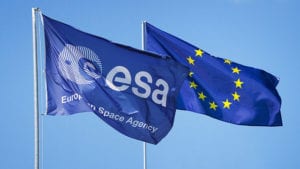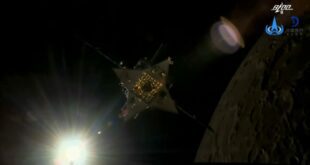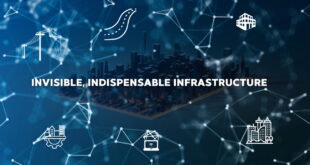 As part of the partnership between SpaceWatch.Global and the European Space Policy Institute, we have been granted permission to publish selected articles and briefs. This is ESPI Briefs No. 35: ‘DG Defence Industry and Space: stakes and challenges’, originally published in October 2019.
As part of the partnership between SpaceWatch.Global and the European Space Policy Institute, we have been granted permission to publish selected articles and briefs. This is ESPI Briefs No. 35: ‘DG Defence Industry and Space: stakes and challenges’, originally published in October 2019.
1. A new Directorate General for Defence Industry and Space

The new set up of the recently appointed European Commission involves a rather substantial reorganisation of the different portfolios within the EU executive and a consequential restructuring of the Directorates- General. The new proposed Commissioner for Internal Market, former French Finance Minister and CEO of ATOS Group, Thierry Breton, is still awaiting his hearing by the European Parliament. In case of approval, the Commissioner will be supported in his functions by a new policy department devoted to Defence Industry and Space for the first time in the history of this Institution.
The establishment of this new Directorate-General specifically addressing space as a domain of action, is a clear recognition of the strong political support of European Member States of the further development of the EU space programme. The decision to bring defence and space within the same Directorate also follows the legacy of the outgoing Junker’s Commission. More specifically, as outlined in the mission letter to the Commissioner, the perimeter of action of the new DG includes to:
- Foster a strong and innovative European space industry;
- Implement the future European Space programme building on the European flagship programmes
- namely Galileo and EGNOS, the EU’s satellite navigation programmes and Copernicus, EU’s Earth
- Observation programme;
- Implement and oversee of the European Defence Fund (EDF), a tool to offer financial support to
- cooperative industrial projects across Europe;
- Ensure an open and competitive European defence equipment market, enforcing EU procurement rules
- on defence;
- Implement the Action Plan on Military Mobility;
- Strengthen the link between Space and Defence.
2. Bringing together different institutional frameworks
Defence and space sectors share quite a number of commonalities in particular related to the strategic significance of these two intertwined industries. However, the approach of the EU to these two domains differs quite substantially.
Space has been formally included among the shared competences of the Union and its Member States (art. 4.2 TEU), while Defence relies on ad hoc agreements defined and implemented on a case-by-case basis by the European Council acting unanimously (art. 24 TEU) and therefore remains embedded within the sovereign powers of each Member State.
The role of the EU in these two domains is therefore different: as far as space is concerned, the EU is responsible for the management of a full-fledged space programme with various components and owns the resulting space infrastructures while, regarding defence, the EU is in charge of the definition of the common security and defence policy (CSDP) and promotes coordination and cooperation between EU countries and their defence industries (PESCO, EDF, CARD).
In the context of the development of EU responsibilities in these two areas, the establishment of a Defence Industry and Space Directorate-General clearly is a major milestone, particularly in light of the potential synergies between these two domains both at operational and political levels. Bringing these two strategic sectors under the same administrative umbrella aims at facilitating the use of EU space capabilities (Galileo, EGNOS, Copernicus, Govsatcom…) for security and defence purposes. This setup will also naturally raise some common policy questions such as how to best support the development of a globally innovative and competitive industrial base contributing to Europe’s strategic autonomy.
3. Addressing different industries
Looking at the industrial landscape, synergies between the two sectors arise in terms of technological development and in the delivery of services that are critical to optimize the planning and deployment of military operations. In this context, the potential for cross-fertilization and for strengthening the related capacity of supply in Europe is unquestionable.
With regard to the geographic distribution, the European scene is dominated by a handful of major established industrial groups active in both space and defence, most prominently Thales, Airbus and Leonardo, and concentrated in few countries. Yet, the space sector nurtured over time a plethora of SMEs and young start-ups scattered across Europe as a result of coordinated efforts of the European Space Agency, EU and national institutions. A similar dispersed industrial structure is not mirrored in the defence sector. Small companies which still form a strong fabric for the defence industry remain often clustered in close proximity of their relevant large system integrators (LSI), thus creating a deep gap between the vast majority of European countries with barely no capabilities in this field contrasting with few leaders concentrating extensive capacities.
Nonetheless, in terms of industry turnover, the space sector hardly compares to defence. According to the figures provided by ASD in 2017 the turnover of the defence industry was approximately 100 B€ (not consolidated) with an employment capacity of about 450,000 people. In the same FY, the space sector totalled a turnover of about 9 B€ (Eurospace consolidated data), counting for about 43,000 full-time employments. And yet, in the framework of the EC budgetary provisions, space is very well served by the communitarian funds with a proposed amount of 16 B€ for the next MFF (2021/2027) whilst 13 B€ will be allocated to the European Defence Fund.
4. Some important questions on the way forward
The establishment of this new Directorate General marks a crucial step forward in a long-standing political development process. This pairing clearly yields an interesting dynamic regarding the long-term development of both sectors in the EU framework, paves the way to further potential synergies and raises important questions for the future conduct of EU Space affairs:
- At programmatic level, how will defence-oriented applications and operations be integrated in the EU space programme? How will this rapprochement support the EU space agenda and priorities, in particular with regards to strategic autonomy?
- At budgetary level, the current ratio of institutional funding supporting R&D between these two domains is quite in favour of space. Will this balance be impacted in the future according to the relative size of the industrial sectors and the needs expressed by Member States?
- At political level, to what extent will Member States with limited industrial military capabilities support the further growth of EU space defence-related budgets and responsibilities? Will the more active ones agree on any additional transfer of sovereignty towards the EU?
- At institutional level, what will be the role of the freshly created EU Space Programme Agency (EUSPA) in defence-oriented activities? What will be the distribution of responsibilities between the various EU actors concerned, namely EUSPA, EEAS, EDA, as well as ESA?
These are just a few of the questions that the next Commissioner and Director General in charge of Defence industry and Space will have to tackle in order to clarify the scope of this enlargement of responsibilities of the European Commission and to propose a way forward toward a clear and ambitious European Space, Security and Defence policy adapted to the current evolution of threats posed to EU citizens and assets.
Rights reserved – this publication is reproduced with permission from ESPI. “Source: ESPI “ESPI Briefs” No. 35, October 2019. All rights reserved”
For more articles please visit ESPI website (www.espi.or.at).





